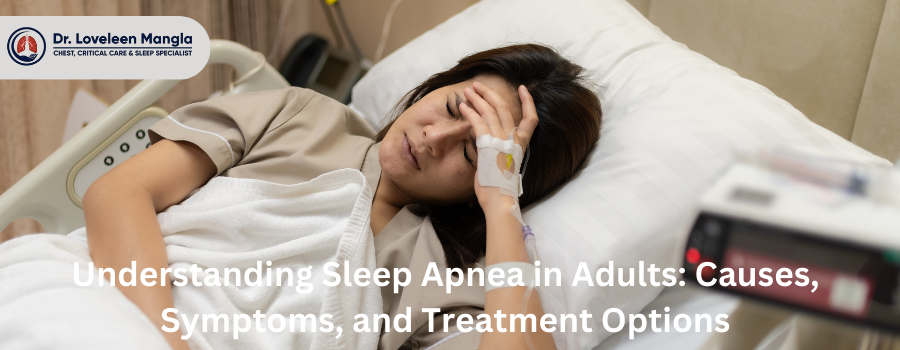Understanding Sleep Apnea in Adults: Causes, Symptoms, and Treatment Options

Sleep is essential for good health, but for millions of adults, a condition known as sleep apnea interferes with their ability to get restful sleep. Sleep apnea is more than just loud snoring—it’s a serious sleep disorder where breathing repeatedly stops and starts throughout the night. If left untreated, it can lead to serious health complications such as heart disease, high blood pressure, and even stroke. Let’s explore the causes, symptoms, and available treatment options for sleep apnea in adults.
What is Sleep Apnea?
Sleep apnea occurs when the muscles in the back of the throat relax too much, blocking the airway and reducing oxygen levels in the body. This triggers the brain to briefly wake the person from sleep so that normal breathing can resume. These interruptions in breathing can happen multiple times during the night, often without the person being aware of it.
There are two main types of sleep apnea:
- Obstructive Sleep Apnea (OSA) – This is the most common form and occurs when the muscles in the throat collapse and block the airway.
- Central Sleep Apnea (CSA) – This form is less common and occurs when the brain fails to send proper signals to the muscles that control breathing.
Some adults may also have complex sleep apnea, a combination of both obstructive and central sleep apnea.
Symptoms of Sleep Apnea
Recognizing the symptoms of sleep apnea is important for seeking timely treatment. The most common signs include:
- Loud, chronic snoring (especially in obstructive sleep apnea)
- Gasping or choking during sleep
- Pauses in breathing during sleep
- Excessive daytime sleepiness or fatigue
- Difficulty concentrating or memory problems
- Morning headaches
- Irritability or mood swings
- Restless sleep or frequent waking up
Many people with sleep apnea are unaware they have it, as they often don’t remember the episodes of interrupted breathing. Usually, a bed partner or family member may notice the signs first.
Causes and Risk Factors of Sleep Apnea
Several factors can increase the risk of developing sleep apnea, including:
- Obesity: Excess weight, especially around the neck, can put pressure on the airway, increasing the likelihood of airway obstruction.
- Age: Sleep apnea becomes more common as people age, particularly in adults over the age of 50.
- Gender: Men are more likely to develop sleep apnea than women, although the risk for women increases after menopause.
- Family history: Genetics can play a role in sleep apnea, as it tends to run in families.
- Lifestyle factors: Smoking, alcohol consumption, and the use of sedatives can increase the likelihood of airway blockages during sleep.
- Nasal congestion: Chronic nasal congestion can lead to airway obstruction, increasing the risk of sleep apnea.
Complications Associated with Sleep Apnea
Untreated sleep apnea can lead to serious health issues, including:
- High blood pressure (hypertension): The repeated drops in blood oxygen levels increase blood pressure, putting extra strain on the cardiovascular system.
- Heart disease: Sleep apnea raises the risk of heart attacks, arrhythmias (irregular heartbeats), and heart failure.
- Type 2 diabetes: Sleep apnea is linked to insulin resistance, increasing the likelihood of developing type 2 diabetes.
- Stroke: Sleep apnea can increase the risk of stroke, as it affects the flow of oxygen to the brain.
- Depression and anxiety: Chronic sleep deprivation caused by sleep apnea can take a toll on mental health.
Diagnosis of Sleep Apnea
If you suspect you have sleep apnea, it’s important to see a doctor for an evaluation. The diagnosis often involves:
- Sleep history: Your doctor will ask about your sleep habits, symptoms, and overall health.
- Physical exam: A thorough examination of your airways, neck, and throat will help identify any obstructions.
- Sleep study (Polysomnography): This is the most definitive test for diagnosing sleep apnea. It records brain waves, blood oxygen levels, heart rate, breathing, and eye and leg movements during sleep.
For milder cases, home sleep tests may also be recommended, which can provide valuable data on breathing patterns while you sleep at home.
Treatment Options for Sleep Apnea
Fortunately, sleep apnea is treatable, and several effective options are available:
Lifestyle Changes
- Weight loss: Losing weight can significantly reduce the symptoms of obstructive sleep apnea.
- Positional therapy: Sleeping on your side rather than your back can help keep the airway open.
- Avoiding alcohol and sedatives: Reducing alcohol intake and avoiding sleep medications can prevent airway muscles from relaxing too much.
Continuous Positive Airway Pressure (CPAP) Therapy CPAP is the most common and effective treatment for moderate to severe obstructive sleep apnea. It involves wearing a mask over your nose or mouth while you sleep. The mask is connected to a machine that delivers a continuous stream of air to keep your airway open throughout the night.
Oral Appliances For those with mild to moderate sleep apnea, oral appliances designed to keep the airway open can be an effective alternative to CPAP. These devices are custom-fitted by a dentist or orthodontist.
Surgery In more severe cases, or when other treatments don’t work, surgery may be recommended. Surgical options include removing excess tissue from the throat, repositioning the jaw, or implanting a device to stimulate the airway muscles.
Conclusion
Sleep apnea is a serious condition that can have far-reaching effects on your health and quality of life. If you or a loved one experiences symptoms such as loud snoring, daytime fatigue, or gasping for air during sleep, it’s essential to seek medical advice. With proper diagnosis and treatment, you can manage sleep apnea effectively and enjoy restful, rejuvenating sleep once again.

